CORDIERITE
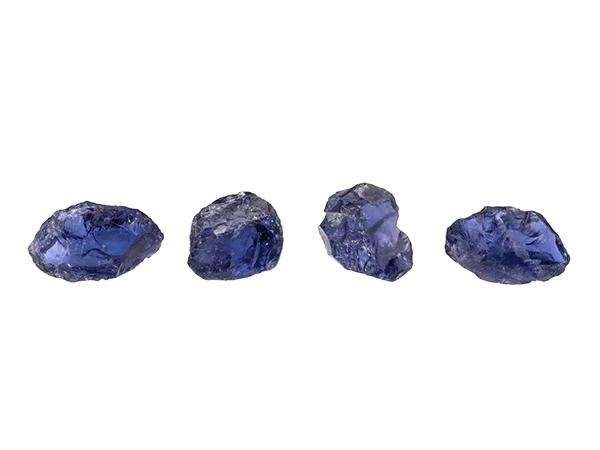
Cordierite is a silicate mineral, usually light blue or light purple, glass luster, transparent to translucent. Cordierite also has a characteristic, with obvious pleochroism (trichromism), emitting different colors of light in different directions. In addition, cordierite is used as a gemstone. In addition, cordierite is widely used as a honeycomb carrier material for automobile purifiers because of its good fire resistance and low thermal expansion rate. Cordierite is produced in schist, gneiss and altered igneous rocks. People therefore also call cordierite a two-color stone.
Artificially can synthesize magnesium cordierite for refractory materials. Cordierite rough is generally 4-5 carats, and larger ones are also found. Cordierite is generally cut into traditional shapes, and the most popular color is blue-violet.
basic information
Inclusions: The inclusions also have considerable variation, including hematite, goethite, apatite, zircon or other gas-liquid two-phase inclusions. The indigo produced in Sri Lanka contains a large number of aligned hematite and goethite thin hexagonal pieces, which are red, like blood spots, hence the name blood drops cordierite.
Cordierite is similar in color to sapphire, so it is also called water sapphire. Moreover, because it has the color and luster of sapphire and the price is much cheaper than sapphire, it is more nicknamed the sapphire of the poor. The energy of cordierite is quite stable and it is not a matter of heating to change its color. Gems.
The main producing areas of cordierite are Brazil, India, Sri Lanka, Myanmar, Madagascar, and Lanzhou, Taiwan. There are also a few discoveries, while cordierite has blue, light blue, light purple, light yellow, and light brown. To the color, one of the most important features of cordierite is its dichroism.
This is the biggest difference between the cordierite and the sapphire. What is the dichroism? It is described in simple words. It is the same gem that appears in two different colors at different angles (pictured). The most common color in its chromaticity is blue, purple, light yellow (or colorless), also because Such cordierite is also known as the two-color stone.
Cordierite is subdivided into three types according to its type, namely, cordierite, cordierite and cordierite.
Physical properties
Color: Gem-grade varieties are blue and blue-violet, and cordierite can also be colorless, yellowish white, green, brown, and gray.
Gloss and transparency: glass luster, transparent to translucent.
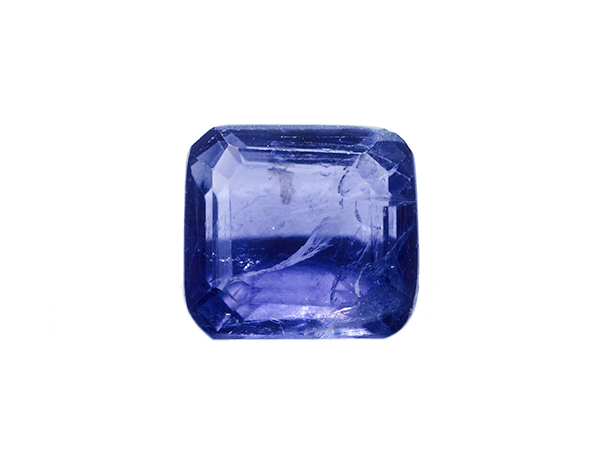
Refractive index and birefringence: RI: 1.54-1.55, DR: 0.01±0.002 is related to the ratio of Mg and Fe in the composition. When Mg is rich, the refractive index is low, while when iron is rich, the refractive index is high.
Polychromaticity: Strong, trichromatic is yellow, yellow, blue. Visible to the naked eye, if you look from different directions, you can see different colors.
Luminescence: none
Absorption spectrum: expressed as iron absorption spectrum.
Cleavage: Cordierite can have three sets of cleavage, where {010} is a medium cleavage, {100} and {001} are incomplete cleavage, and the fracture is a jagged.
Protrusion: negative or positive low protrusion
Scoring hardness: Mohs hardness is 7~7.5
The relative density: 2.60, gradually increases as the content of Fe increases.
Crystal system: orthorhombic system
Crystal: short column
Aggregate type: granular, blocky
Others:
(1) brittle;
(2) refractive index 1.542 ~ 1.551;
(3) transparent to translucent;
(4) crystal couple with repeated twins and pseudo-hexagon;
(5) when the crystal is wrapped with a twisted line When small minerals such as stone and zircon are used, the multicolor halo of lemon yellow can often be seen.
Chemical properties
chemical composition
(Mg, Fe2+)2Al3 [AlSi5O18]·H2O
Chemical classification
Silicate
Chemical properties
(1) Magnesium in the component can be replaced by a small amount of manganese.
(2) Aluminum in the composition, which can be replaced by some high-priced iron.
Microscopic feature
Common mineral inclusions include hematite or goethite, apatite, zircon and gas liquid inclusions. One of the cordierite packages produced in Sri Lanka is mainly hematite and goethite. The color is red. Most of the particles are plate-like and needle-like, and are oriented. When the inclusions appear in large quantities, the cordierite can be presented. Red, this cordierite is also known as "Bloodshot".
Origin of name
The English name for cordierite is Cordierite, which is named after the French geologist P. L. A. Coedier, and the gem-grade cordierite, English name Iolite or Dichroite. Iolite is derived from the Greek word for "violet" and symbolizes the color characteristics of gem-quality cordierite. Cordierite has obvious pleochroism, and it can be seen from the different angles with the naked eye, and its color can be obviously changed.
The chemical composition is a silicate rich in iron, magnesium and aluminum. The magnesium in the composition can be replaced by iron or manganese, and part of the aluminum can also be replaced by iron. The crystals are mostly short-column, and occasionally contain inclusions such as sillimanite, spinel, zircon, apatite, and mica in the crystal. The color is generally light blue, dark blue or grayish blue, some are colorless, white, gray, light yellow, light purple or light brown, while weathered, it is slightly green. If the degree of weathering increases, cordierite can be changed to mica, chlorite or talc.
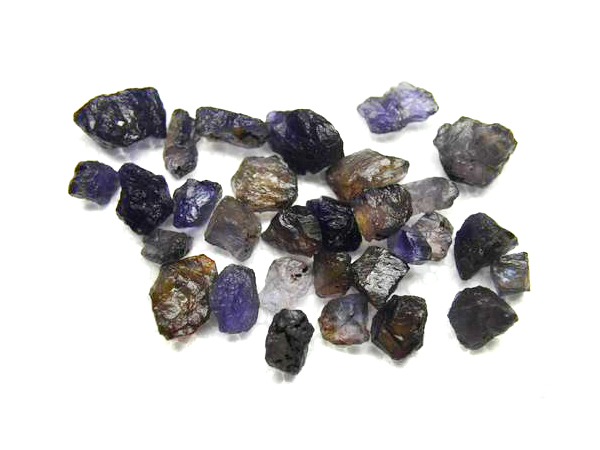
Causes and causes
Cordierite is a typical metamorphic mineral, metamorphic. It is mainly produced in gneiss or schist and altered igneous rocks with high aluminum content. The gem-grade cordierite mainly exists in the magnesia-changed volcanic rocks. It can also be found in some granites, and is often associated with garnet, andalusite, corundum, quartz, spinel, and sillimanite.
Common variety
Iron sapphire
The two main components of cordierite, magnesium and iron, can be replaced by the same image. When the content of iron is greater than that of magnesium, it is called iron cordierite.
Cordierite
That is, when the magnesium content is higher than the iron content, it is called cordierite, and the famous magnesium-rich variety produced in India is often used to make gemstones, also known as Indian stones.
Blood point cordierite
The main producing area is in Sri Lanka. The main feature is that the internal iron oxide bath is rich in content and arranged in a specific direction so that the cordierite has a ribbon and is called blood cordierite.
Important place of origin
Taiwan, China
(1) In the Andesite of Ludao and Lanyu.
(2) Anshan Rock in the northern part of Taiwan’s Shajiashan and Yilan Mountain.
(3) In the basalt of Chiyu, Wuhu.
(4) Among the slate in the high mountains of the Central Mountain Range.
Other parts of the world.
(1) Haddam, NewLondon, Guilford, and Plymouth, Connecticut, USA.
(2) GarnetIsland of Northwest Territories, Canada.
(3) Bodenmais and Wechselburg, Bavaria, Germany.
(4) Biskupice, DolníBory, V??ná in the Czech Republic.
(5) Orijarvi and Pielavesi in Finland.
(6) Norwegian Krager?, Arendal, Bamblesector.
(7) Naversberg, Sweden.
(8) CabodeGato of Spain.
(9) Greenland Tajik SWofRankful Sasykskyarea.
(10) Mt.Bity of Madagascar.
(11) Sri Lanka.
(12) BlueDragonmine of CapeProv., South Africa, GuadonFarm of NorthCape.
(13) WhiteWell of WesternAustralia, Australia.
(14) Umburang, Paraiba, Brazil.
(15) Soto of Argentina.
(16) Parral of Chihuahua, Mexico.
(17) Myanmar.
(18) Tanzania.
The main purpose
The color is beautiful and transparent, it can be used as a gem. Generally, gem-quality cordierite is blue and violet, and blue cordierite is also known as "WaterSapphire".
Used in the production of ceramics and glass materials, widely used in automotive purifier carrier basic materials
Identification feature
(1) Refractive index: 1.542~1.551
(2) Hardness: 7
(3) The crystal is often a short hexagonal column
(4) The color is mostly blue or grayish blue
In addition, the appearance of blue cordierite is quite similar to that of blue sapphire, but cordierite has considerable pleochroism and hardness, refractive index and specific gravity are lower than sapphire. Cordierite is mainly produced in Brazil, India, Sri Lanka, Myanmar, Madagascar, and Lanyu in Taiwan.
The colors of cordierite are blue, light blue, light purple, light yellow, and light brown. Color has to mention the most important feature of cordierite, that is, its pleochroism. This is the biggest difference between the use of the naked eye to distinguish cordierite from sapphire. What is polychromaticity? It is described in simple words. The same gem appears to have two or three different colors at different angles, and the most common colors in its pleochroism are blue, purple, and pale yellow (or colorless).
Famous stone comparison
Gemstones similar to cordierite include sapphire, amethyst, stellite, tourmaline, and tanzanite. The key distinctions are: RI value and DR value, relative density value, color pleochroism, light-colored variety interferogram and fluorescence characteristics of stellite.
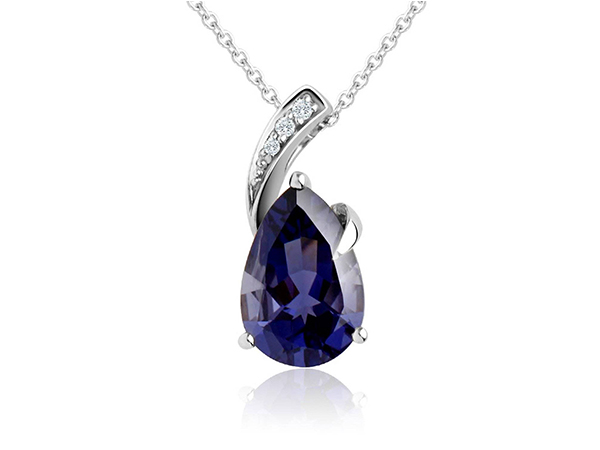
Sapphire: bright glass luster, RI1.76-1.78 DR0.008 one-axis crystal (-), pleochroism is obvious dichroic blue to blue-green, typical spectrum is three strong absorption narrow bands in the blue zone (450, At 460 and 470 nm), the hexagonal or straight-edge growth ribbon, rutile needle-like inclusions and gas-liquid two-phase inclusions were observed.
Blue tourmaline: RI1.62-1.65 DR0.018 One axis (-) Multicolor is obviously strong (dichroic), SG3.01-3.11 sinks in 2.65 heavy liquid, while cordierite SG is small, at 2.65 The liquid is floating.
Tanzanite: The apparent trichromaticity is similar to cordierite, but the three directional colors of each are different. The RI and SG of Tanzanite are higher than cordierite, RI1.69-1.70 DR0.009 two-axis crystal gemstone, SG3.35.
Historical legend
More than 1,000 years ago, the Vikings did not have any navigation tools, and the sky was often overcast, crossing the icy ocean and traveling to the Americas. Legend has it that they traveled with magic, but now it seems that they may be guided by science.
There are many sources of information and information that in the year 980, that is, more than 400 years before Columbus discovered the Americas, the Veyonics sailed to the coastal areas of North America. The ship was led by Ericil Rosso, who departed from Bergen, Norway, first to Iceland, then to Greenland, and finally to Canada's Labrador to the coast of the American continent.
At this high latitude, the sky is always gloomy and visibility is extremely low. During the day, the sun is hidden behind the clouds, and the stars are not visible at night. At that time, there were no tools and means to help people to clarify the direction, but according to legend, these northerners have a magical tool for their long-distance travel, which is the sun stone.
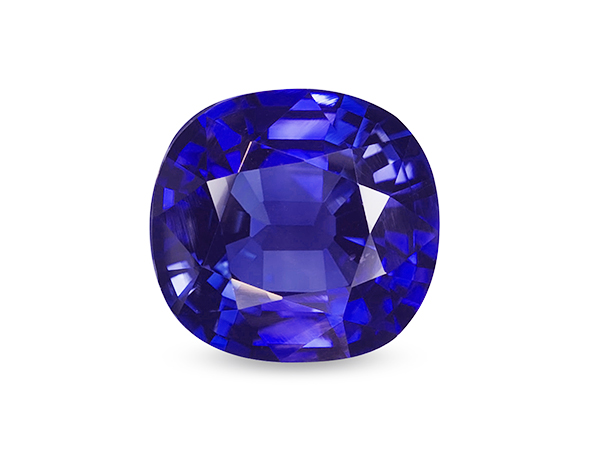
The Vikings arrived in Greenland in 982, and according to some historians, they even reached the coast of North America. At the time they had no navigation tools in their hands. In fact, many years later, around 1044, the Chinese invented the compass. But how did the Vikings reach the coast of the American continent? In 1967, the Danish archaeologist Thorkild Ramsko explained this theory, and now this theory has attracted the attention of scholars. According to Ramsko's explanation, the ancient northerners unconsciously used the physical properties of an ore.
Ramsko believes that the famous sun stone that appears as a magical navigator in many stories is nothing but an ore crystal called cordierite. This is an ore with birefringence and dichroism, which means that it selectively absorbs light radiation. When the light passes through cordierite, the light passing through the cordierite changes color, from purple to blue to yellow, according to the different planes. Can be traced back to the location of the light source.
Many scientists believe that the Vikings once owned this ore, and they pointed to the sky to know the position of the sun and thus identify the direction.
When the light source (here the sun) is shielded (such as the clouds), polarized light occurs. Since the high latitudes are often cloudy, and in these areas the sun is close to the horizon for a long time, the polarization of sunlight is more pronounced. The reason for this is that the incident angle of the light that hits the earth is large and the thickness of the atmosphere through which the sunlight passes is large.
Even when the sun has set, but the sun is still shining on the atmosphere, this phenomenon still exists. Cordierite crystals are also able to find the direction of the sun according to the color of the transmitted polarized light. Another evidence that is favorable to Ramsko's theory is that Norway's cordierite deposits are very rich, so it is easy for Vicenzas to obtain such ores, but since they do not understand the physical properties of such ores, it is natural. It is attributed to a magical power.
Industrial characteristics
[Molecular formula] (Mg, Fe) 2Al3 [AlSi5O18]
[Chemical composition] Mg and Fe in the composition are replaced by complete isomorphism, but most cordierite is rich in magnesium, because in the crystal structure of cordierite, Mg and Fe are four-coordinated, and the radius of Mg2+ is higher than Fe2+. Small, more stable into the tetrahedron. Al3+ outside the backbone can be replaced by Fe3+. In addition, the components often contain H2O, K, Na, etc., in the large pores in the structure.
[Crystal structure] orthorhombic system; D202h-Cccm, a0=1.713 to 1.707 nm, b0=0.980 to 0.973 nm, c0=0.935 to 0.929 nm, Z=4. It has the same structure as beryl, but there is Al→Si in the hexagonal ring, and thus the symmetry decreases. It is worth noting that Mg2+ and Fe2+ generally have six coordinations, but four coordinations in cordierite.
[Form] Intact crystals do not appear often, sometimes as fake hexagonal prism crystals.
[Physical properties] Colorless, or light blue, light yellow; glass luster; transparent to translucent. Cleavage {010} medium; shell-like fracture. Hardness 7 to 7.5. The relative density is 2.53 to 2.78.
[genesis and occurrence] is a typical metamorphic mineral produced in gneiss, chip-bearing rocks and altered igneous rocks.
[Main use] The largest characteristic of cordierite is its small coefficient of thermal expansion, so it is widely used in ceramics and glass industries to improve its resistance to quenching and rapid heat.
